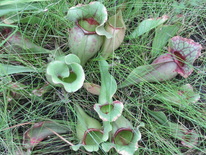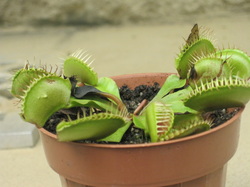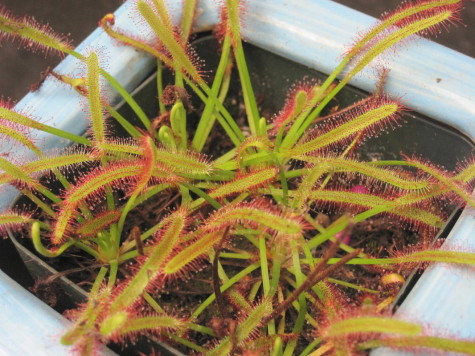Chomp! The World of Carnivorous Plants
Have you heard about the unique kinds of plants that survive by eating insects? 7th grader James Hirota has a passion for raising these carnivorous plants and delights in sharing his extensive knowledge with others.
It all began 3 years ago when his grandmother bought him a pitcher plant at the LA county fair. That sparked his  interest and he got a book called The Savage Garden by Peter D’Amato all about carnivorous plants. He decided this was something he might want to get into, and from there “it just kind of unfolded.” He went on to acquire more plants shortly after his first one.
interest and he got a book called The Savage Garden by Peter D’Amato all about carnivorous plants. He decided this was something he might want to get into, and from there “it just kind of unfolded.” He went on to acquire more plants shortly after his first one.
James said that he would describe carnivorous plants as being “miracles of nature” – plants that survive in very difficult conditions. He related that there are 657 known species, as well as the species not discovered yet! He continued, “There’s another thing that would surprise a lot of people is that when you think of carnivorous plants, they’re so exotic, they should be native to like Madagascar and all the jungles….but really they can be found in literally our backyards….They’re found all over the world on all continents except for Antarctica.”
James said he currently has only seven plants, but is hoping to get more in future years. Living in southern California, he grows his plants outdoors year round. His collection includes 2 purple pitcher plants, 1 yellow trumpet plant, 1 Venus Flytrap, 1 sundew, 1 butterwort, and 1 tropical pitcher plant.
One of his biggest surprises was when he got the book The Savage Garden and realized he was doing so many things wrong.
That book actually saved the lives of some of his plants because they were being attacked by diseases and he didn’t even know it!
Thankfully he was able to get a fungicide to spray on the plants that killed all the Botrytis.
So, how much time would you expect a hobby like this to take? James said that usually three times a week he waters and prunes back his plants, and so that takes about 30-45 min. However, he said as a beginner wanting to learn as much as he could about his plants, “I used to spend like five hours during the summer out there taking care of them  and taking notes on them.
and taking notes on them.
“It’s funny that as the years go on, these plants actually become more like pets than garden plants, because some of them seem to have their own faces and you get emotionally attached to them.”
The most exciting part for James about raising these plants is watching them catch their insects. Different plants catch insects in different ways. He went on to describe many of the various traps in detail.
“So there’s the one that we always think of when we think of carnivorous plants, called the Venus flytrap, the most famous one of all. It has a trap which is called a snap-trap, it’s exclusive to the Venus flytrap and its completely aquatic counterpart, the water-wheel plant, which is much, much, much smaller…
“So at the end of the leaf there’s this mouth-like trap. Its prey, usually flies, …(where you get the name from) are attracted there by the nectar that is secreted on the inside of the trap. And so the unfortunate insect, fooled by it’s own greed, it flies in there, wanders around, and touches one or more of those little trigger hairs on the inside… at least two times each. It’s really interesting… it’s still being researched, but no one exactly knows what causes the trap to shut, but we have a pretty good idea. We think that the trigger hairs send an impulse that sends a mild electrical current up the leaf and that leaf causes the cells on one half of the trap to expand with water and therefore force the trap closed.” There are at least six types of traps and probably more not discovered.
 James related that he will be raising carnivorous plants for the rest of his life. He is aiming to get a degree in botany, and he’s hoping to go into the research field, look for new species in Indonesia, or do a whole array of other things related to these fascinating plants.
James related that he will be raising carnivorous plants for the rest of his life. He is aiming to get a degree in botany, and he’s hoping to go into the research field, look for new species in Indonesia, or do a whole array of other things related to these fascinating plants.
James also had some words for those who might be inspired by this story to start raising carnivorous plants themselves:
“If any growers read this article in California, I’d like them to know that there’s the Los Angeles Carnivorous Plant Society down here. And then I highly, highly, highly recommend reading that book that I told you about earlier, it’s really helpful.”
He also wished to reach hands out towards the only business of its kind, California Carnivores – the world’s largest collection for buying carnivorous plants.
But James concluded with a sad truth,
“Amidst all this wonder and glory of carnivorous plants, there’s one disheartening fact: that these plants are disappearing from our earth.”
In North America their habitats are being drained or flooded for reservoirs, and they’re disappearing because of deforestation in places like Borneo and Indonesia. Some plants are severely endangered, and one protected species has only 50 known plants in existence.
has only 50 known plants in existence.
However James did say that there are all sorts of things people can do. You can donate to organizations dedicated to protecting these plants; there are many different types of conservation efforts going on. Some places buy land for sale that contains carnivorous plant habitats to prevent it being destroyed by housing developments. They have numerous different ways to try and protect these unique and wonderful plants.
James ended, “So it’s not all dark and gloomy, there is still hope.”

Editor in Chief Kathryn Fox is a senior at Mother of Divine Grace School. Contact her at [email protected]





